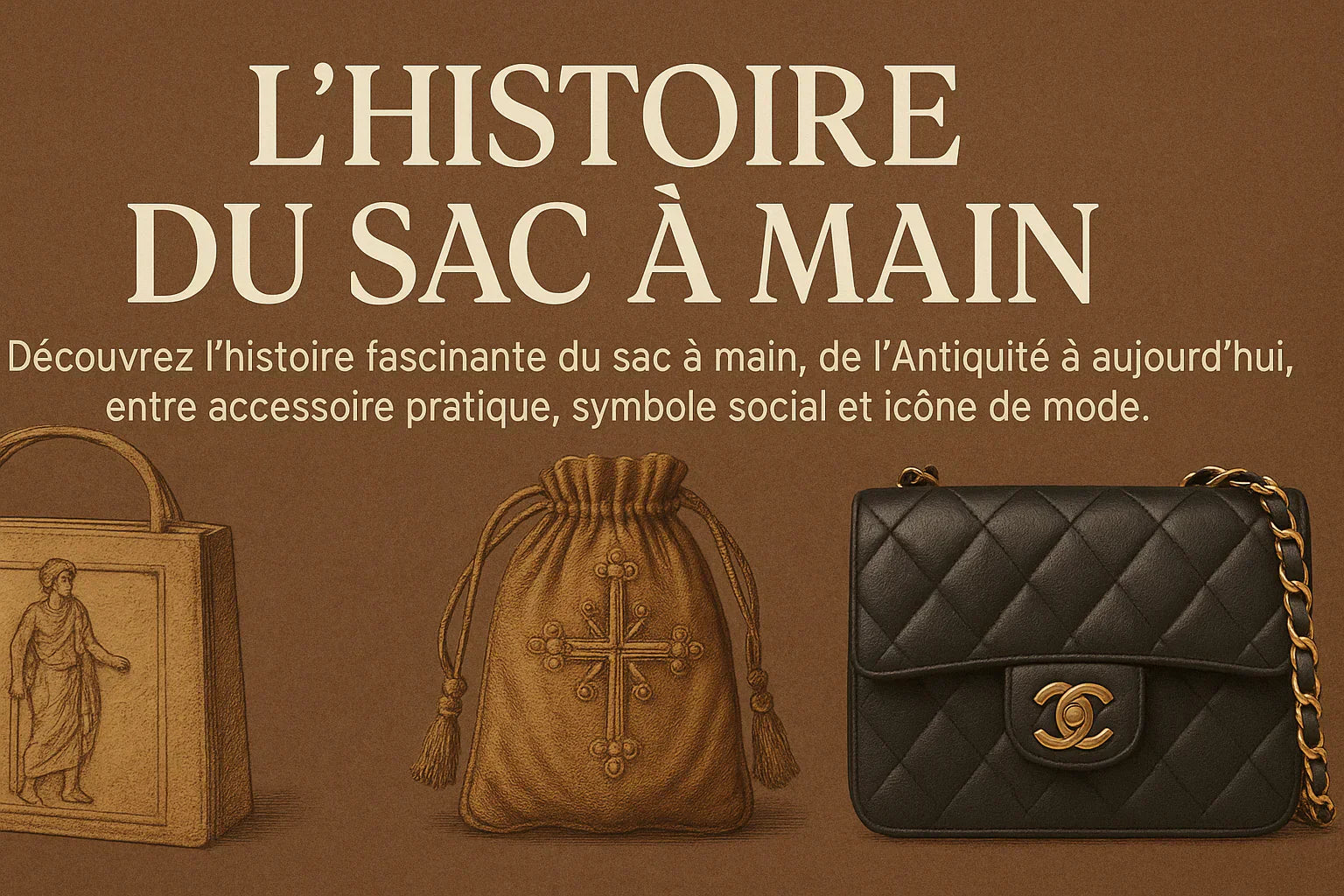
The history and origin of the handbag
Have you ever wondered why the handbag occupies such a central place in the history of fashion and social symbolism?
Discover its captivating journey, from its ancient origins to today's iconic models. By exploring its evolution, you'll understand how this practical accessory has become a marker of identity, prestige, and emancipation throughout the centuries.
Summary
- The ancient origins of the handbag
- The evolution of the handbag through the centuries
- The handbag as a social and cultural symbol
- Iconic handbags and their heritage
The ancient origins of the handbag
The history of the handbag dates back to antiquity . The word "bag" comes from the Hebrew "sak," referring to a coarse fabric made of goat hair. In ancient Greece, the kibisis was a bag associated with Hermes, the god of commerce and travelers. In Rome, the drawstring purse appeared for carrying money.
The first handbags were used by Greek travelers like Perseus and Roman citizens. The Greek kibisis, an attribute of Hermes, was used to carry precious objects. The Roman purse, worn at the waist, contained coins such as the aureus, sestertius, and denarii. These accessories combined functionality and social symbolism .
| Period | Bag type | Main function |
|---|---|---|
| Ancient Greece | Kibisis | Transport of valuables for travelers |
| Roman Antiquity | Sotck exchange | Contains money, worn at the waist |
| Middle Ages | Almsgiver | Carrying money and everyday items, attached to the belt |
| Renaissance | Purse | An accessory of social distinction, adorned with pearls |
The evolution of the handbag through the centuries
The medieval alms purse and its uses
The alms purse was an essential accessory in the Middle Ages. This object, worn at the waist, was used to carry money, keys, or religious items. Both functional and decorative, it was considered an integral part of the costume.
The finest models featured exquisite embroidery with gold thread and pearls. They were sometimes given as tokens of love or favor. This bag symbolized the wealth and status of its owner.
From the Renaissance to the 18th century
The purse dominated the Renaissance as a choice accessory. This clasped bag attached to the belt combined practicality and elegance for the nobility.
- Purses : Large purses with clasps popular until the 16th century, used by the nobility to carry money and precious objects.
- Alms purses : Medieval purses worn on the belt, which evolved into accessories embroidered with gold thread and beads for the wealthy classes.
- Ballantines: Bags that appeared in 1795 with Empire dresses, designed to be worn outdoors as romantic fashion accessories.
- German purses : 15th century models with multiple pockets, like the Wismar purse intended for wealthy women.
The 19th century and the industrial revolution
The fitted dresses of the 19th century made pockets obsolete. Women adopted external bags like the Ballantine. This trend marked a turning point in the history of leather goods.
The 19th century saw the rise of the leather industry. Chrome tanning, discovered in 1850, transformed production. Leather became more supple and resistant , allowing the manufacture of practical and affordable bags.
The modern 20th-century handbag
The 20th century marked a turning point with the diversity of styles. Leather bags, synthetic materials, and creations by renowned designers appeared. This accessory became an essential fashion item.
The World Wars transformed the design of shoulder bags. Inspired by military models, these practical bags adapted to the needs of active women. Their functionality and durability made them ideal everyday companions.
The handbag as a social and cultural symbol
From social status to personal expression
The handbag reveals social position . Throughout history, its shape, ornamentation, and material have indicated the social class of its wearer.
Your identity is expressed through your handbag . Bold colors reflect a bold personality. Minimalist designs appeal to those who appreciate simplicity. The shape, size, and contents reveal your lifestyle and personal aspirations.
The influence of fashion designers
Luxury brands are redefining the handbag as an essential fashion item. Chanel, Hermès, and Louis Vuitton are leading the way with creations that have become timeless.
| Handbag | Luxury home | Year of creation | Distinctive characteristic |
|---|---|---|---|
| Kelly | Hermes | 1935 | Renamed in homage to Grace Kelly, an eternal symbol of luxury |
| Birkin | Hermes | 1984 | Created after a meeting with Jane Birkin, legendary waiting list |
| Speedy | Louis Vuitton | 1930 | A flagship model reinvented by Pharrell Williams in 2023 |
| Lady Dior | Dior | 1994 | Renamed in honor of Lady Diana, the epitome of elegance |
| Baguette | Fendi | 1997 | The iconic "It" bag of the 2000s, regularly reinterpreted |
Hermès, with the Kelly and the Birkin, embodies exclusivity. Chanel revolutionized accessories with the 2.55. Louis Vuitton dominates with its iconic designs. These designers transformed the handbag into a coveted investment .
The handbag in different cultures
- Japanese furoshiki : Folded and knotted cloths for carrying objects, symbols of elegance and respect for traditions.
- Maasai purses : Bags adorned with colorful beads carried by warriors, expressing social status and rites of passage.
- Inuit shoulder bags : Sealskin models, designed to withstand the elements and convey ritual motifs.
- Medieval alms bags : Religious objects distributed to the poor, marking the piety and prestige of their owner.
Handbags vary across cultures. In Asia, the furoshiki embodies elegance and the preservation of traditions. In Africa, Maasai beads tell a story of social history. Among the Inuit, sealskin shoulder bags combine functionality with ritual significance. To discover a wide selection, explore the bag-haven handbag collections available online. In medieval Europe, alms bags revealed the religious and social status of their owner.
The handbag transcends its primary function to become a vehicle for cultural values . It marks rites of passage, symbolizes piety or elegance. Each civilization adapts this accessory to its traditions, making it a witness to social evolution.
Iconic handbags and their heritage
Luxury brands and their iconic models
Hermès designed the Kelly in 1928, then the Birkin in 1984. They became symbols of luxury and coveted investment objects worldwide.
Chanel, Louis Vuitton, and other renowned fashion houses have transformed the handbag into an object of desire . They have introduced technical and aesthetic innovations, profoundly influencing the fashion industry. You can now find models that combine functionality and prestige.
| Handbag | Luxury home | Year of creation | Distinctive characteristic |
|---|---|---|---|
| Kelly | Hermes | 1935 | Renamed in homage to Grace Kelly, an eternal symbol of luxury |
| Birkin | Hermes | 1984 | Created after a meeting with Jane Birkin, legendary waiting list |
| Speedy | Louis Vuitton | 1930 | A flagship model reinvented by Pharrell Williams in 2023 |
| Lady Dior | Dior | 1994 | Renamed in honor of Lady Diana, the epitome of elegance |
| Baguette | Fendi | 1997 | The iconic "It" bag of the 2000s, regularly reinterpreted |
Luxury brands shape the history of the handbag. Hermès, with the Kelly and the Birkin, embodies exclusivity. Louis Vuitton establishes the bag as an iconic travel accessory. Chanel reinvents the design with the 2.55. These creations define the standards of modern luxury.
The handbag, from antiquity to the 21st century, embodies a captivating evolution between function and symbolism. Initially a utilitarian accessory, it has become a marker of identity , reflecting fashion and emancipation. Discovering its history allows you to make an informed choice of a bag that combines practicality and personal expression, in harmony with your style and values.

